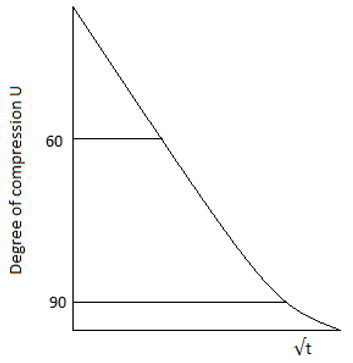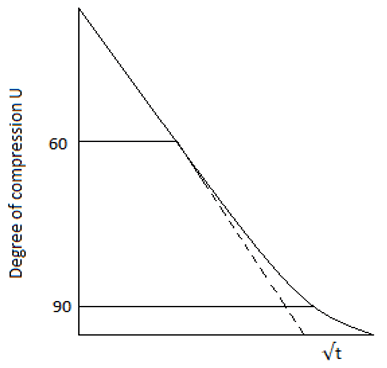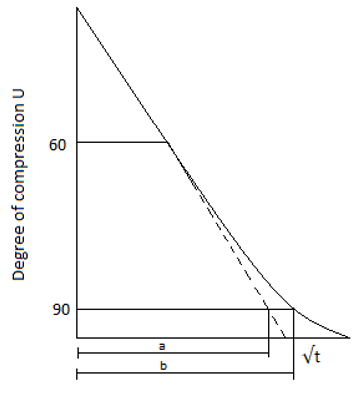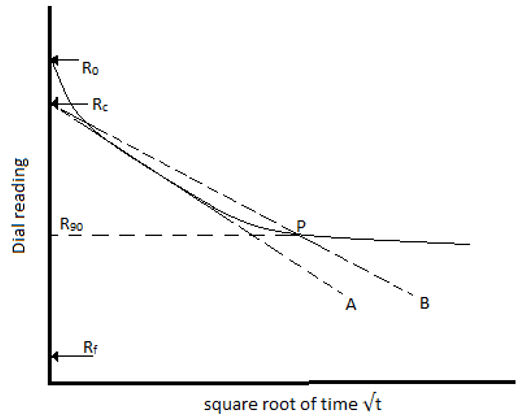This set of Soil Mechanics Multiple Choice Questions & Answers (MCQs) focuses on “Determination of Coefficient of Consolidation – 1”.
1. The coefficient of consolidation can be determined by comparing characteristics of _______
a) time factor Tv and degree of consolidation U
b) degree of consolidation U and pore pressure u
c) pore pressure u and effective pressure σ’
d) effective pressure σ’ and total pressure σ
View Answer
Explanation: The coefficient of consolidation can be determined by comparing characteristics of the theoretical relationship between time factor Tv and degree of consolidation U to the relationship between the elapsed time and degree of consolidation of specimen as obtained in the laboratory.
2. The coefficient of consolidation can be found by _____________
a) square root of time fitting method only
b) logarithm of time fitting method only
c) both square root of time fitting and logarithm of time fitting method
d) no method is available
View Answer
Explanation: Out of the many methods available, the two important methods are:
- square root of time fitting method
- logarithm of time fitting method.
3. The square root of time fitting method the theoretical graph is plotted between _____
a) \(\sqrt{T_v}\) is abscissa and U is ordinate
b) U is abscissa and \(\sqrt{T_v}\) is abscissa
c) Tv is abscissa and U is ordinate
d) \(\sqrt[3]{T_v}\) is abscissa and U is ordinate
View Answer
Explanation: The square root of time fitting method the theoretical graph is plotted between \(\sqrt{T_v}\) as abscissa and U as ordinate.

4. The curve is straight up to _______________
a) U = 60%
b) U = 65%
c) U = 70%
d) U = 55%
View Answer
Explanation: The square root of time fitting method the theoretical graph is plotted between \(\sqrt{T_v}\) as abscissa and U as ordinate and the curve is straight is up to U = 60%.

5. The abscissa at U=90% is roughly equal to ________ times the abscissa at U=60%.
a) 0
b) 1.10
c) 1.15
d) 1.00
View Answer
Explanation: The abscissa at U=90% is roughly equal to 1.15 times the abscissa at U=60%. It is represented in the diagram.
b/a=1.15.

6. The use of square root of fitting method was suggested by ________
a) Terzaghi
b) Taylor
c) Darcy
d) Skempton
View Answer
Explanation: The use of square root of fitting method was suggested by Taylor in 1948. Darcy did his research in the permeability of soils. Skempton is Known for his pore pressure coefficients A and B.
7. From the practical data, in square root of time fitting, ______ curve is plotted.
a) time t in abscissa and dial reading R in Ordinate
b) t2 in abscissa and dial reading R in Ordinate
c) root of time √t in abscissa and dial reading R in Ordinate
d) t3 in abscissa and dial reading R in Ordinate
View Answer
Explanation: From the practical data, in square root of time fitting, root of time √t in abscissa and dial reading R in Ordinate curve is plotted. The dial reading represents the compression of the specimen.
8. In the graph, point Rc represents ________

a) initial consolidation
b) corrected zero reading
c) secondary consolidation
d) initial zero reading
View Answer
Explanation: When the straight portion of the line is produced back to meet the ordinate, then the reading in the ordinate corresponding to the intersection of the line, it is known as corrected zero reading.
9. The consolidation between Ro and Rc is called ______________
a) initial consolidation
b) corrected zero reading
c) secondary consolidation
d) initial zero reading
View Answer
Explanation: The consolidation between Ro and Rc is called initial consolidation. Iinitial consolidation is when a load is applied to a partially saturated soil, a decrease in volume occurs due to expulsion and compression of air in the voids. A small decrease in volume occurs due to compression of solid particles.
10. The coefficient of consolidation from square root of time fitting method is calculated from the equation _________
a) \(c_v=\frac{(T_v)_{90} d^2}{t_{90}} \)
b) \(c_v=\frac{(t_{90})_{90} d^2}{T_{90}} \)
c) \(c_v=\frac{(T_v)_{90} d}{T_{90}} \)
d) \(c_v=\frac{(T_v)_{90} d^3}{t_{90}} \)
View Answer
Explanation: The coefficient of consolidation is calculated from the equation of,
\(c_v=\frac{(T_v)_{90} d^2}{t_{90}}, \)
where, cv=coefficient of consolidation
(Tv)90=time factor corresponding to 90% consolidation
t90=elapsed time for 90% consolidation
d=average drainage path for pressure increment.
Sanfoundry Global Education & Learning Series – Soil Mechanics.
To practice all areas of Soil Mechanics, here is complete set of 1000+ Multiple Choice Questions and Answers.
If you find a mistake in question / option / answer, kindly take a screenshot and email to [email protected]
- Apply for Civil Engineering Internship
- Check Geotechnical Engineering I Books
- Practice Civil Engineering MCQs
- Check Civil Engineering Books
- Practice Geotechnical Engineering II MCQs
